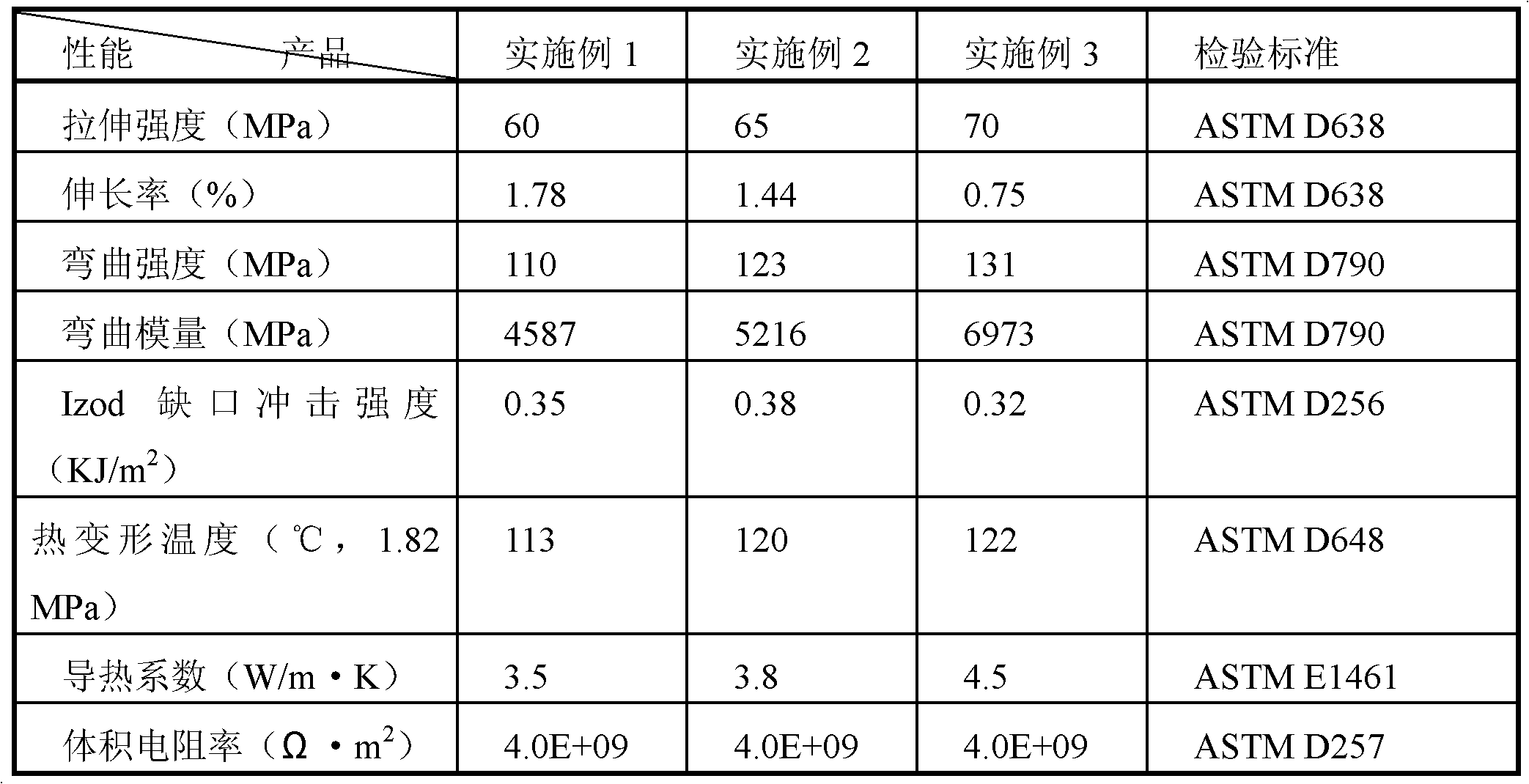Insulation heat conduction glass fiber reinforced PC/ABS alloy material and preparation method thereof
An insulating and thermally conductive, alloy material technology, applied in the field of alloy materials, can solve the problems of poor thermal conductivity, decrease in impact strength and tensile strength, limiting the application of PC/ABS alloys, etc., to achieve improved thermal conductivity, good insulation and thermal conductivity, expansion Application-wide effects
- Summary
- Abstract
- Description
- Claims
- Application Information
AI Technical Summary
Problems solved by technology
Method used
Image
Examples
Embodiment 1
[0033] (1) Pretreatment of thermally conductive fillers: add 30 parts of 20-500 micron large particle size thermally conductive filler magnesium oxide and 10 parts of 0.5~5 micron small particle size thermally conductive filler magnesium oxide into the high-speed mixer, and then add 3 parts of NDZ- 201 titanate coupling agent, mix evenly, then put it into an oven, and dry it at 100°C for 3-5 hours to further combine the coupling agent and thermal conductive filler, and set aside;
[0034] (2) Pretreatment of glass fibers: add 10 parts of E-type glass fibers with a fiber diameter of 5 to 24 μm, and 2 parts of NDZ-201 titanate coupling agent into a high-speed mixer and mix evenly, and set aside;
[0035] (3) The pretreatment thermally conductive filler obtained in step (1), 50 parts of bisphenol A polycarbonate PC with a viscosity-average molecular weight of 20000 to 30000 and 50 parts of ABS (wherein the content of butadiene is 30 to 60%) ), join in the high-speed mixer, add 0....
Embodiment 2
[0038] (1) Pretreatment of thermally conductive fillers: add 70 parts of 20 to 500 micron large particle size thermal conductive filler alumina and 20 parts of 0.5 to 5 micron small particle size thermal conductive filler alumina into the high-speed mixer, and then add 3 parts of KH- 560 silane coupling agent, mix evenly, then put it into an oven, and dry it at 100°C for 3-5 hours to further combine the coupling agent and thermal conductive filler, and set aside;
[0039] (2) Pretreatment of glass fibers: add 20 parts of E-type glass fibers with a fiber diameter of 5 to 24 μm, and 2 parts of KH-560 silane coupling agent into a high-speed mixer and mix evenly, and set aside;
[0040] (3) The pretreatment thermally conductive filler obtained in step (1), 70 parts of bisphenol A polycarbonate PC with a viscosity-average molecular weight of 20000 to 30000 and 30 parts of ABS (wherein the content of butadiene is 30 to 60%) ), added to a high-speed mixer, added 0.5 parts of 1010 and...
Embodiment 3
[0043] (1) Pretreatment of thermally conductive fillers: add 120 parts of 20-500 micron large particle size thermally conductive filler silicon carbide and 30 parts of 0.5~5 micron small particle size thermally conductive filler silicon carbide into the high-speed mixer, and then add 3 parts of NDZ- 201 titanate coupling agent, mix evenly, then put it into an oven, and dry it at 100°C for 3-5 hours to further combine the coupling agent and thermal conductive filler, and set aside;
[0044] (2) Pretreatment of glass fibers: add 30 parts of S-type glass fibers with a fiber diameter of 5 to 24 μm, and 2 parts of KH-560 silane coupling agent into a high-speed mixer and mix evenly, and set aside;
[0045] (3) The pretreatment thermally conductive filler obtained in step (1), 90 parts of bisphenol A polycarbonate PC with a viscosity average molecular weight of 20000 to 30000 and 30 parts of ABS (wherein the content of butadiene is 30 to 60%) ), added to a high-speed mixer, added 0.5...
PUM
| Property | Measurement | Unit |
|---|---|---|
| Diameter | aaaaa | aaaaa |
| Thermal conductivity | aaaaa | aaaaa |
Abstract
Description
Claims
Application Information
 Login to View More
Login to View More - R&D
- Intellectual Property
- Life Sciences
- Materials
- Tech Scout
- Unparalleled Data Quality
- Higher Quality Content
- 60% Fewer Hallucinations
Browse by: Latest US Patents, China's latest patents, Technical Efficacy Thesaurus, Application Domain, Technology Topic, Popular Technical Reports.
© 2025 PatSnap. All rights reserved.Legal|Privacy policy|Modern Slavery Act Transparency Statement|Sitemap|About US| Contact US: help@patsnap.com

